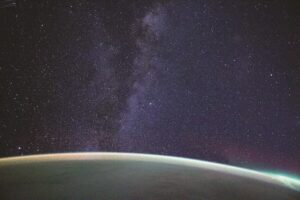The Perseid meteors are here. Every year at this time, Earth passes through the debris trail of Comet Swift-Tuttle on our way around the Sun. The debris consists mostly of tiny pebbles the size of beach sand. When these strike our atmosphere at around 36 miles per second, friction heats them to temperatures over 3,000 degrees Fahrenheit, vaporizing the rock and leaving behind a glowing trail of ionized gas. We call these shooting stars.
The Perseids reached peak intensity on the night of Aug. 12. That would have been our chance to see 40 or more per hour, but clouds moved in that night. But you can also see the meteors for a couple of weeks on either side of peak night. The best time is an hour or two before sunrise, but I realize most readers won’t be heading outside at 4 a.m. to watch for shooting stars. You can see the Perseids starting around 9 p.m., too — there just won’t be as many.

All you have to do is head outside and look up. Perseids can appear anywhere in the sky. The key is patience. Keep your eyes on the sky and look for a fast-moving streak of light, lasting just a second or two. If you’re lucky, you might see an unusually large Perseid, which will be brighter and longer lasting. While you’re waiting, you might also see some satellites pass by or maybe even one of the notorious Starlink satellite chains that threaten scientists’ ability to study the universe.
After bagging a few Perseids and a satellite or two, why not stay outside a little longer? Warm summer nights are a great time to get to know the sky better. You won’t need dark-adapted vision to find the brighter stars and their constellations. And there’s no shame in using a planetarium app on your smartphone, either. Star Walk, Sky Safari, and Stellarium are all excellent.
A printed star chart and red flashlight work even better than a smartphone app. New stargazers should check out something called a star wheel, or rotating star finder. This is a chart of the stars and constellations that rotates to show you only what’s visible at a given time of year. The Night Sky by David S. Chandler is small enough to tuck into a backpack or purse. For older eyes like mine that need something larger (16 inches diameter), I recommend Guide to the Stars by Ken Graun. If you want a full-size book with chapters and charts for each month of the year, my favorite is The Monthly Sky Guide by Ian Ridpath and Wil Tirion.
Once you’re ready, start with the Summer Triangle: three bright stars that are prominent during the summer months. Vega is the brightest summer star, shining a brilliant blue-white almost directly overhead. Vega is about 25 light-years away and resides in the constellation Lyra, which resembles an instrument called a lyre. Fun fact: in the movie Contact an advanced alien civilization placed robotic listening posts in orbit around thousands of stars, including Vega, to listen for radio transmissions from young, undiscovered civilizations. The one at Vega was the one that first detected the radio signals emanating from Earth and initiated contact with Earthlings.
Once you have Vega, face northeast and let your eyes drift down until you reach a star only a little less bright than Vega. That’s Deneb, part of the constellation Cygnus. Cygnus is my favorite constellation. It truly looks like what it’s named for: cygnus is the Roman version of the Greek word for swan. Deneb is the tail of the swan. Its wide wings stretch to either side, while its long, graceful neck extends for over 10 degrees of sky.
Now let’s find the third star of the Summer Triangle. With Vega and Deneb in sight, look east (that will be to the right) for another bright star that forms a triangle with them. That’s Altair, in the constellation Aquila (Latin for eagle). Aquila has a shape similar to Cygnus, though its stars are mostly dimmer than those in Cygnus, making the shape harder to discern.
To end your summer tour, turn your gaze south and low to the horizon. If you’ve had your smartphone out, put it away and give your eyes some time to adapt. Within a few minutes you should see a misty glow extending from the southern horizon up and across the sky. That’s the Milky Way, our home galaxy; what you’re seeing is the concentrated glow of countless stars too faint and far away for us to discern individually. The Sun orbits in one of the Milky Way’s grand spirals. When you look south during summer, you’re looking straight from our spiral into the core of the Milky Way, where millions of stars are packed relatively close together.
Sagittarius and Scorpius are two major constellations in this part of the sky. With your star chart and new knowledge of the sky, see if you can pick out their shapes and some of the interesting targets they host. Your chart will list many, often with the designation “M” followed by a number. This refers to the Messier catalog of objects. Something to learn about next month.
Until then, keep your star chart handy. Clear skies!
Columnist Justin Samaha will be setting up his telescope at First Encounter Beach in Eastham on Aug. 23 and 24. Join him at sunset, clear skies and good weather permitting, for a guided look at the summer night sky.



